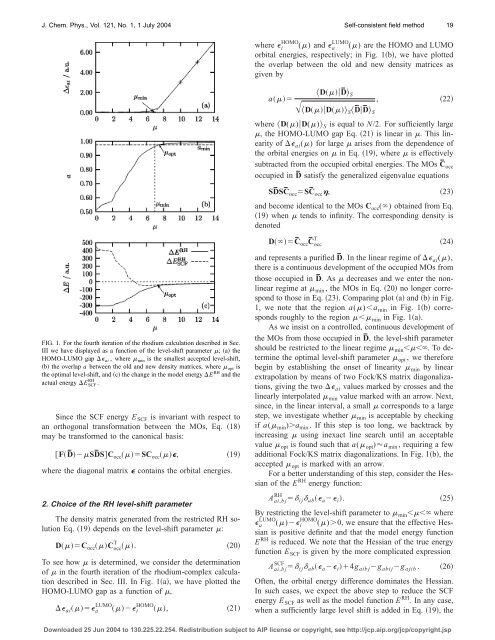Get my PhD Thesis
Get my PhD Thesis
Get my PhD Thesis
You also want an ePaper? Increase the reach of your titles
YUMPU automatically turns print PDFs into web optimized ePapers that Google loves.
J. Chem. Phys., Vol. 121, No. 1, 1 July 2004 Self-consistent field method<br />
19<br />
where i HOMO () and a LUMO () are the HOMO and LUMO<br />
orbital energies, respectively; in Fig. 1b, we have plotted<br />
the overlap between the old and new density matrices as<br />
given by<br />
DD¯ S<br />
a<br />
,<br />
DDS D¯D¯ S<br />
22<br />
where D()D() S is equal to N/2. For sufficiently large<br />
, the HOMO-LUMO gap Eq. 21 is linear in . This linearity<br />
of ai () for large arises from the dependence of<br />
the orbital energies on in Eq. 19, where is effectively<br />
subtracted from the occupied orbital energies. The MOs C¯occ<br />
occupied in D¯ satisfy the generalized eigenvalue equations<br />
SD¯SC¯occ SC¯occ ,<br />
23<br />
and become identical to the MOs C occ () obtained from Eq.<br />
19 when tends to infinity. The corresponding density is<br />
denoted<br />
T<br />
DC¯occ C¯occ<br />
24<br />
FIG. 1. For the fourth iteration of the rhodium calculation described in Sec.<br />
III we have displayed as a function of the level-shift parameter ; a the<br />
HOMO-LUMO gap ai , where min is the smallest accepted level-shift,<br />
b the overlap a between the old and new density matrices, where opt is<br />
the optimal level-shift, and c the change in the model energy E RH and the<br />
actual energy E RH SCF .<br />
Since the SCF energy E SCF is invariant with respect to<br />
an orthogonal transformation between the MOs, Eq. 18<br />
may be transformed to the canonical basis:<br />
FD¯SD¯SC occ SC occ ,<br />
where the diagonal matrix contains the orbital energies.<br />
2. Choice of the RH level-shift parameter<br />
19<br />
The density matrix generated from the restricted RH solution<br />
Eq. 19 depends on the level-shift parameter :<br />
DC occ C T occ . 20<br />
To see how is determined, we consider the determination<br />
of in the fourth iteration of the rhodium-complex calculation<br />
described in Sec. III. In Fig. 1a, we have plotted the<br />
HOMO-LUMO gap as a function of ,<br />
ai a LUMO i HOMO ,<br />
21<br />
and represents a purified D¯. In the linear regime of ai (),<br />
there is a continuous development of the occupied MOs from<br />
those occupied in D¯. As decreases and we enter the nonlinear<br />
regime at min , the MOs in Eq. 20 no longer correspond<br />
to those in Eq. 23. Comparing plot a and b in Fig.<br />
1, we note that the region a()a min in Fig. 1b corresponds<br />
roughly to the region min in Fig. 1a.<br />
As we insist on a controlled, continuous development of<br />
the MOs from those occupied in D¯, the level-shift parameter<br />
should be restricted to the linear regime min . To determine<br />
the optimal level-shift parameter opt , we therefore<br />
begin by establishing the onset of linearity min by linear<br />
extrapolation by means of two Fock/KS matrix diagonalizations,<br />
giving the two ai values marked by crosses and the<br />
linearly interpolated min value marked with an arrow. Next,<br />
since, in the linear interval, a small corresponds to a large<br />
step, we investigate whether min is acceptable by checking<br />
if a( min )a min . If this step is too long, we backtrack by<br />
increasing using inexact line search until an acceptable<br />
value opt is found such that a( opt )a min , requiring a few<br />
additional Fock/KS matrix diagonalizations. In Fig. 1b, the<br />
accepted opt is marked with an arrow.<br />
For a better understanding of this step, consider the Hessian<br />
of the E RH energy function:<br />
A RH ai,bj ij ab a i . 25<br />
By restricting the level-shift parameter to min where<br />
LUMO a () HOMO i ()0, we ensure that the effective Hessian<br />
is positive definite and that the model energy function<br />
E RH is reduced. We note that the Hessian of the true energy<br />
function E SCF is given by the more complicated expression<br />
A SCF ai,bj ij ab a i 4g aibj g abij g ajib . 26<br />
Often, the orbital energy difference dominates the Hessian.<br />
In such cases, we expect the above step to reduce the SCF<br />
energy E SCF as well as the model function E RH . In any case,<br />
when a sufficiently large level shift is added in Eq. 19, the<br />
Downloaded 25 Jun 2004 to 130.225.22.254. Redistribution subject to AIP license or copyright, see http://jcp.aip.org/jcp/copyright.jsp

















